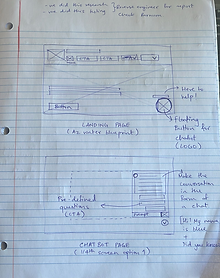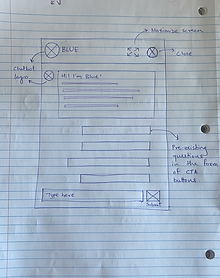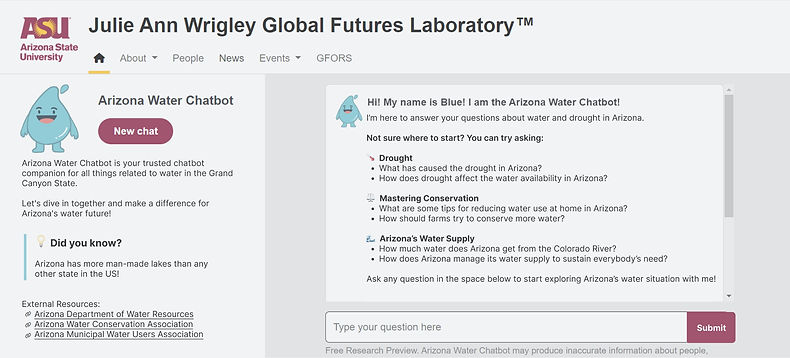Arizona Water Chatbot

Duration
August 2023 to November 2023
Problem
Users that have never used a chatbot have issues while interacting with it.
Goal
Regardless of proficiency with technology, all users must be able to easily use the new interface.
Arizona Water Chatbot is an initiative taken up by Julie Wrigley Global Futures Laboratory, Arizona State University. This chatbot will cater to any of the water related questions a user may have in the state of Arizona. The answers are specific to the AZ region only.
With the interface redesign, users will be able to interact with the chatbot easily.
My Roles
Wireframes
I sketched out a few paper wireframes for creating a 1/4th screen chatbot interface. I later converted these into digital wireframes.


High Fidelity Prototype
We prioritized user experience by developing a compact, 1/4th screen chatbot design. This unobtrusive approach integrates seamlessly without compromising functionality. Users can easily engage via a text input field or predefined quick-access questions. The chatbot minimizes to a chat tab for easy switching between content, and maximizes for a focused experience. This iterative design, inspired by successful websites like LinkedIn and IKEA, offers users control with minimize, maximize, and close buttons, ensuring a user-friendly and engaging experience.

Splash Page Redesign
While working on the interface of the chatbot, I proposed including a "Did You Know?" Trivia section about “Water in Arizona” on the splash page of the chatbot. I presented a splash page redesign to her where I included one trivia about water in Arizona. It read "Arizona has more man-made lakes than any other state in the United States!". My proposal was to code the chatbot to display a new trivia every time the page was refreshed. My professor, Dr. Lauer, absolutely loved the idea and requested the developers to add that feature.

Heuristic Evaluation
I used Jakob Nielsen's 10 principles of Heuristic Evaluation to evaluate ChatGPT and Gemini (Artificial Intelligence) websites. Following are some of the Key Findings:
1. User friendly
Gemini overtook ChatGPT in regards to the manner the prompt was answered
2. Intuitively
Gemini is more intuitive compared to ChatGPT as the user interface is designed to be more simple to interpret to a new user
3. Features
ChatGPT lacked some features like auto-completion, auto-correct and edit question, which gemini encompassed.
User Research Methods
I conducted a Comparative Analysis to further evaluate ChatGPT and Gemini. Listed below are some of the findings.
ChatGPT
Accurate
Efficient
Conversational tone (can be changed as per requirement)
Gemini
Creative text generation
Accessible
Integration of Google products
Next, I interviewed a few Arizona residents to understand their knowledge about water in AZ. I formulated a set of questions to derive the depth of knowledge.
Question 1: Have you faced any water related issues in Arizona?
Question 2: What information source do you rely on for water updates/news?
Question 3: Do you use any official website for water related information?
Question 4: Does your household practice any water conservation methods?
Question 5: Can you tell me about a time that you interacted with a chatbot? How easy or difficult was it?
Question 6: What is a common misconception that you've heard about water in Arizona
Question 7: What source do you get water from?
Based on the above questions, I came up with a Persona that represents the majority of the people

Usability Testing
I formulated a document which consists of a Test Plan, Consent Form, Pre-Test Questionnaire, Script, Scenarios and Tasks, Post-Test Questionnaire and an Observation Sheet. To view the document, please click on "View Write Up".
Conducted a comprehensive user testing session involving 3 participants. Each participant navigated through 3 distinct scenarios, completing specific tasks on the website. I documented their verbal feedback and observed their reactions at each stage.
Positives
1. Participants appreciated the chatbot's ability to provide useful information and specific details about water usage and conservation in their areas.
2. The chatbot was generally perceived as a helpful and credible tool, particularly for addressing local water-related queries and concerns.
Areas for Improvement
More detailed information about water sources and the specific needs of different residential settings was desired by some.